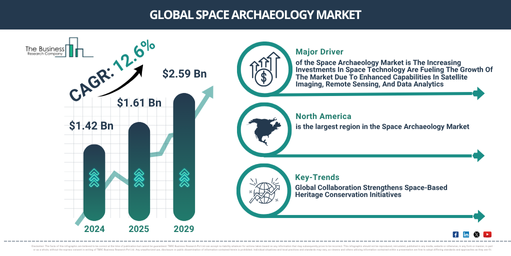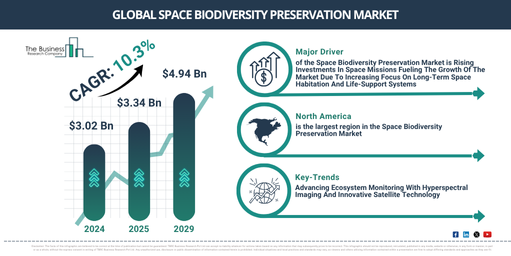Space Archaeology Industry Forecast 2025–2029: Growth Opportunities Ahead
Limited Offer: Get Comprehensive Trade & Market Analysis at 20% Off – Use Code ONLINE20
How Is The Space Archaeology Market Size Expected To Change From 2024 To 2034?
Recent advancements have propelled significant expansion within the space archaeology market, which is projected to increase its valuation from $1.42 billion in 2024 to reach $1.61 billion by the following year, reflecting a compound annual growth rate of 13.0%. This upward trajectory throughout the historical phase is primarily fueled by several factors, including the enhancement of satellite imaging capacities, an escalation in the exploration of bygone eras and ancient societies, the greater deployment of remote sensing tools, strengthening partnerships uniting archaeologists with governmental space organizations, and the continually augmenting repository of historical data captured from Earth observation satellites.
Forecasting rapid expansion ahead, the market encompassing space archaeology is projected to reach a valuation of $2.59 billion by the year 2029, propelled by a compound annual growth rate (CAGR) of 12.7%, with this upward trajectory being fueled by developments in AI-driven image interpretation, the heightened need to safeguard historical legacies, the proliferation of commercial satellite systems, augmented financial support for orbital investigation, and the increasing incorporation of Geographic Information Systems within archaeological practice, while key shifts anticipated across this period involve progress in hyperspectral imaging capabilities, sophisticated methods for data amalgamation, novel approaches to shrinking satellite technology, the implementation of machine learning within archaeological studies, and the adoption of platforms that leverage crowd-sourced information.
Download Your Free Report Sample:
https://www.thebusinessresearchcompany.com/sample.aspx?id=25582&type=smp
Which Demand Drivers Are Supporting The Space Archaeology Market Expansion?
Anticipated greater capital injections into space technologies are poised to accelerate the market expansion for space archaeology in the future. This allocation of financial capital toward creating and implementing tools for space investigation, remote sensing, and data gathering constitutes investment in space technology, which finds its main impetus in governments prioritizing advanced satellite systems to bolster worldwide tracking and charting functions. Such technological funding directly benefits space archaeology by refining capabilities in satellite imagery acquisition, sensing techniques, and analytical processes; for illustration, the European Space Agency, an organization established by several European governments, reported in December 2024 that global space expenditures attained €121 billion (equivalent to $138.75 billion) during 2024, marking a 7% year-over-year growth from 2023, with civilian expenditure accounting for 47% of that total, a 5% gain over the preceding year; consequently, this escalating commitment to space technology funding serves as a primary catalyst for the advancement of the space archaeology sector.
Which Application Segments Are Driving Demand In The Space Archaeology Market?
The space archaeology market covered in this report is segmented –
1) By Technology: Remote Sensing, Satellite Imaging, Ground-Penetrating Radar, Other Technologies
2) By Application: Historical Site Discovery, Artifact Analysis, Environmental Monitoring, Other Applications
3) By End-User: Academic Research, Government Agencies, Private Sector, Other End-Users
Subsegments:
1) By Remote Sensing: Hyperspectral Imaging, Light Detection And Ranging (LiDAR), Multispectral Imaging, Thermal Imaging, Synthetic Aperture Radar (SAR)
2) By Satellite Imaging,: Optical Imaging Satellites, Radar Imaging Satellites, CubeSats And SmallSats Imaging, Geostationary Satellites, Low Earth Orbit (LEO) Satellites
3) By Ground-Penetrating Radar: High-Frequency Ground-Penetrating Radar Systems, Low-Frequency Ground-Penetrating Radar Systems, Airborne Ground-Penetrating Radar, Vehicle-Mounted Ground-Penetrating Radar, Handheld Ground-Penetrating Radar Devices
4) By Other Technologies: Drone-Based Imaging, Artificial Intelligence And Machine Learning For Data Analysis, Photogrammetry, Three-Dimensional (3D) Modeling And Visualization Tools, Magnetometry Sensors
What Long-Term Trends Are Expected To Influence The Space Archaeology Market?
Leading corporations within the extraterrestrial archaeology sector are concentrating their efforts on creating sophisticated methodologies, notably fostering international connectivity, in order to improve the dissemination of data and expedite the identification and safeguarding of historical locations through remote sensing from orbit. This concept of international networking encompasses partnerships and the mutual exchange of expertise and assets among various nations to realize shared objectives in research and development. As an illustration, in May 2025, HIST, the International Centre on Space Technologies for Natural and Cultural Heritage, which functions as a global hub from China for merging space-based science with the protection of cultural treasures, commenced its third operational cycle, spanning from 2025 through 2033. This particular phase was set into motion following a fresh accord joining forces between the Chinese Academy of Sciences, UNESCO, and HIST itself. The alliance is dedicated to augmenting the application of spatial technologies for keeping watch over and securing heritage sites officially recognized by UNESCO, thereby manifesting a reinforced dedication to backing worldwide heritage preservation efforts consistent with the UN’s 2030 Sustainable Development Agenda; this commencement of the subsequent phase clearly indicates a widening scope of global partnership and technological advancement in heritage defense leveraging space assets.
Who Are The Major Stakeholders Operating In The Space Archaeology Market?
Major Companies operating in the space archaeology market are Airbus, National Aeronautics and Space Administration (NASA), Hexagon AB, Trimble Inc., European Space Agency (ESA), The German Aerospace Center, Maxar Technologies, L3Harris Technologies, Planet Labs, ICEYE Ltd., Surrey Satellite Technology Limited (SSTL), BlackSky Technology Inc., Capella Space Corp., GHGSat Inc., SatSure, Satellite Imaging Corporation, Satellogic, Astro Digital, Environmental Systems Research Institute Inc. (Esri), Nara Space Technology Inc., Umbra Lab Inc.
View The Detailed Report For More Insights
https://www.thebusinessresearchcompany.com/report/space-archaeology-global-market-report
Which Regions Are Driving Innovation In The Space Archaeology Market?
North America was the largest region in the space archaeology market in 2024. Asia-Pacific is expected to be the fastest-growing region in the forecast period. The regions covered in the space archaeology market report are Asia-Pacific, Western Europe, Eastern Europe, North America, South America, Middle East, Africa.
Request Your Customized Report Here:
https://www.thebusinessresearchcompany.com/customise?id=25582&type=smp
Browse Through More Reports Similar to the Global Space Archaeology Market 2025, By The Business Research Company
Space Robotics Global Market Report 2025
https://www.thebusinessresearchcompany.com/report/space-robotics-global-market-report
Janitorial Services Global Market Report 2025
https://www.thebusinessresearchcompany.com/report/janitorial-services-global-market-report
Ai In Space Exploration Global Market Report 2025
https://www.thebusinessresearchcompany.com/report/ai-in-space-exploration-global-market-report
Get in touch with us:
The Business Research Company: https://www.thebusinessresearchcompany.com/
Americas +1 310-496-7795
Asia +44 7882 955267 & +91 8897263534
Europe +44 7882 955267
Email us at [email protected]
Follow us on:
LinkedIn: https://in.linkedin.com/company/the-business-research-company
YouTube: https://www.youtube.com/channel/UC24_fI0rV8cR5DxlCpgmyFQ
Global Market Model: https://www.thebusinessresearchcompany.com/global-market-model



